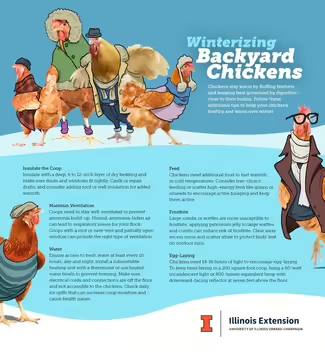
Winter begins challenges to the small flock chicken owner. There are issues that need to be solved: keeping the water from freezing, preventing the birds from getting frostbite, and maintaining egg production.
Winterize the Coop
Chickens need a dry, draft-free, and well-ventilated building to stay healthy and productive. A deep, 6 to 12-inch layer of dry bedding on the floor will provide insulation and help to keep your birds' feet warm. Keep roosts and nesting boxes clean. Check your chicken coop for drafts and caulk or repair those areas. You should never see air moving the chicken’s feathers in the coop during the winter. Adding insulation to the roof and walls will help keep your birds warm all through the winter. Make sure all doors and windows fit tightly and they can be closed securely to keep out predators and vermin.
We want a draft-free chicken coop, but it must be well ventilated to prevent the build-up of ammonia from the litter and to reduce moisture levels. Humid, ammonia laden air in the coop will result in the flock having respiratory and health issues. A building with a roof or eave vent and a partially open window will provide the needed ventilation for a dry, warm place for your birds.
Water
How are you going to provide your flock with clean, fresh water? Chickens need access to water at least every 10 hours, day and night. Prevent water from freezing by installing a heater in the waterer or by using heated a water bowl. When using heaters or heated bowls, make sure the electrical cords and connections are off the floor and not accessible to the chickens. Check daily for water spills and leaks, since these can cause increased moisture in the coop and health issues.
Feed
Your chickens will need more food in the winter to stay warm. Feed a good, balanced diet. You might consider allowing your birds to eat free-choice. Chickens will adjust their eating according to the temperature. Another option to free-choice feeding is to scatter high-energy feed like grains or oilseeds in the evening in the coop. This will encourage the birds to be active and forage through the litter for their feed. Also, this foraging activity will help to turn over the litter and keep the birds from pecking each other.
Frostbite
Chickens with large combs or wattles are more susceptible to frostbite. Keep this in mind when selecting which breeds to have in your flock. For small flocks, applying petroleum jelly to large wattles and combs will reduce the chance for frostbite. If you let your birds outside during the day and there is snow on the ground, remove it from the run or scatter straw to protect their feet from freezing.
Light and Egg Laying
Chickens need 14-16 hours of light to encourage egg-laying. Hanging a 60-watt incandescent light or an 800-lumen equivalent lamp with a downward-facing reflector at seven feet above the floor will provide sufficient light for 200 square feet of coop floor area. This little bit of light will keep the hens laying all through the winter.
With a little planning and daily monitoring, we can keep our small chicken flocks healthy and productive all through the winter months.
